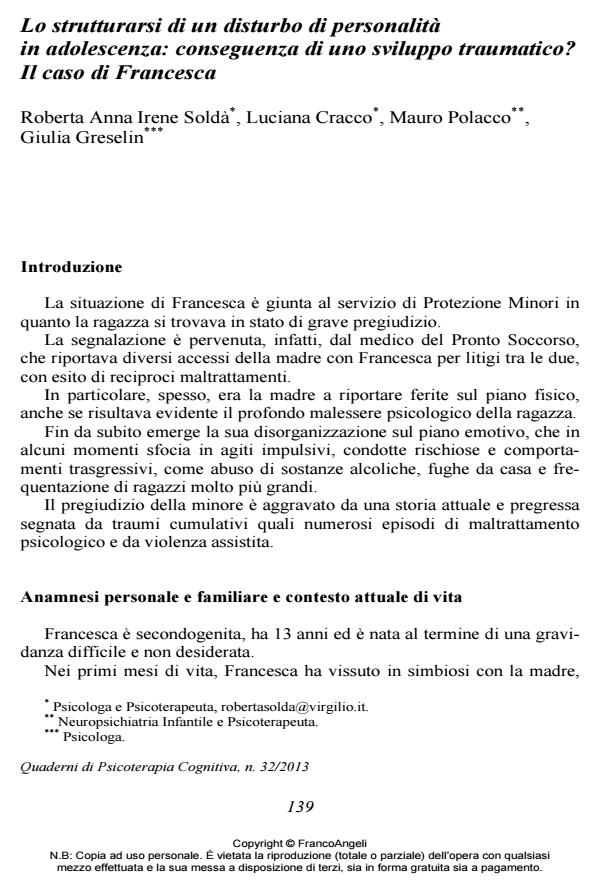Complex post traumatic stress disorder and avoidant personality: A case of sexual abuse
Journal title QUADERNI DI PSICOTERAPIA COGNITIVA
Author/s Roberta Anna Irene Soldà, Luciana Cracco, Mauro Polacco, Giulia Greselin
Publishing Year 2013 Issue 2013/32 Language Italian
Pages 10 P. 139-148 File size 323 KB
DOI 10.3280/QPC2013-032010
DOI is like a bar code for intellectual property: to have more infomation
click here
Below, you can see the article first page
If you want to buy this article in PDF format, you can do it, following the instructions to buy download credits

FrancoAngeli is member of Publishers International Linking Association, Inc (PILA), a not-for-profit association which run the CrossRef service enabling links to and from online scholarly content.
The case study below, illustrates the methods of intervention that references to the complex cognitive and constructivist approach, together with the use of specific techniques and procedures in the treatment of traumatic spectrum disorders (Liotti, Farina, 2011). Through careful psychological assessment, in addition to detecting the comorbidity between major depressive disorder and avoidant personality disorder, it was possible to highlight specific patterns that are common to patients who are victims of abuse: despair, hostility, derealization, loss of coherence in the self-representation, deficit in emotional regulation, irritability and a strong dependence, coexisting with an anxious-avoidant attachment type. The typical dysfunctional patterns, demonstrate that the dissociative mode, which is implemented as a defensive mechanism designed to shield the patient from an intolerable reality, is automated in adulthood, becoming a protective shield against painful and unmanageable emotionalism. The procedures used in the various stages of intervention, pointed out that the outcome depends on the synchronization and integration of theoretical models and protocols. Thanks to the positive dynamics of development exhibited by the patient, the focus is on two topical key: the effectiveness of complex cognitive and constructivist model concerning the intervention with the type of patient victim of abuse; the need to approach complexity by multimodal and multi-level intervention, respect to which the main objective is given by overcoming critical in relationships, through activation of the motivational cooperative system and consolidation of the therapeutic alliance.
Keywords: Complex post traumatic stress disorder (cPTSD), avoidant personality disorder, dissociative experience, cognitive complex therapy (CCT), sexual abuse
- American Psychiatric Association (2000). Diagnostic and Statistical Manual of Mental Disorder.
- Fourth Edition. Washington D.C.: Text Revision (trad. it. DSM-IV-TR. Manuale diagnostico e statistico dei disturbi mentali V, Milano: Masson, 2002).
- Bleiberg E. (2001). Treating personality disorders in children and adolescents: a relationals approach. New York: Guilford Pubblications, M.D. (trad. it. Il trattamento dei disturbi di personalità nei bambini e negli adolescenti: un approccio relazionale, 2003, Giovanni Fioriti Editore, Roma).
- Di Maggio G., Semerari A. (2003) (a cura di). I Disturbi di personalità. Modelli e trattamento.
- Stati mentali, metarappresentazione, cicli interpersonali. Roma-Bari: Laterza.
- Herman J.L. (1992). Complex PTDS: a syndrome in survivors of prolonged and repeated trauma. Journal of Traumatic Stress, 5 (3): 377-391.
- Isola L., Mancini F. (2007) (a cura di). Psicoterapia cognitiva dell’infanzia e dell’adolescenza. Milano: Franco Angeli.
- Lanius A.R., Vermetten E., Clare P. (2012) (a cura di G. Tagliavini). L’impatto del trauma infantile sulla salute e sulla malattia. L’epidemia nascosta. Roma: Giovanni Fioriti.
- Liotti G. (1994). La dimensione interpersonale della coscienza. Roma: Carocci.
- Liotti G., Farina B. (2011). Dimensione dissociativa e trauma dello sviluppo. Cognitivismo Clinico, 8 (1): 3-17.
- Liotti G., Farina B. (2011). Sviluppi traumatici. Eziopatogenesi, clinica e terapia della dimensione dissociativa. Milano: Raffaello Cortina.
- Putnam F.W. (2005). La dissociazione nei bambini e negli adolescenti. Roma: Astrolabio.
- Slade A. (2002). Keeping the baby in mind. A critical factor in perinatal mental health. Zero to three, Jun/July: 10-16.
- Steinberg M., Schnall M. (2001). La dissociazione. I cinque sintomi fondamentali (trad. it. Milano: Raffaello Cortina, 2006).
- Tagliavini G. (2011). Modulazione dell’arousal, memoria procedurale ed elaborazione del trauma: il contributo clinico del modello polivagale e della psicoterapia sensomotoria. Cognitivismo Clinico, 8 (1): 60-72.
- Van der Kolk B. (1994). The body keeps the score: memory and the evolving psychobiology of post traumatic stress. Harv Rev Psychiatry, 1 (5): 253-265.
- Van der Kolk B.A. (2005) (a cura di). Il Disturbo Traumatico dello Sviluppo: verso una diagnosi razionale per i bambini cronicamente traumatizzati. In: V. Caretti, G. Craparo (a cura di). Trauma e Psicopatologia. Un approccio evolutivo-relazionale. Roma: Astrolabio, 2009.
Roberta Anna Irene Soldà, Luciana Cracco, Mauro Polacco, Giulia Greselin, Lo strutturarsi di un disturbo di personalità in adolescenza: conseguenza di uno sviluppo traumatico? Il caso di Francesca in "QUADERNI DI PSICOTERAPIA COGNITIVA" 32/2013, pp 139-148, DOI: 10.3280/QPC2013-032010